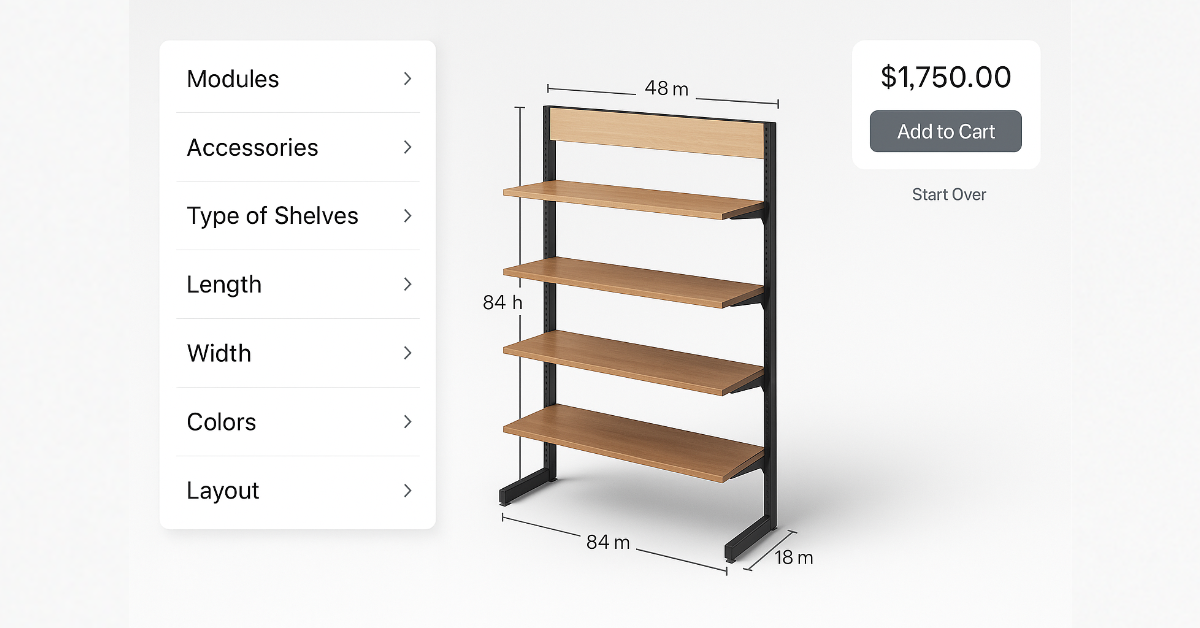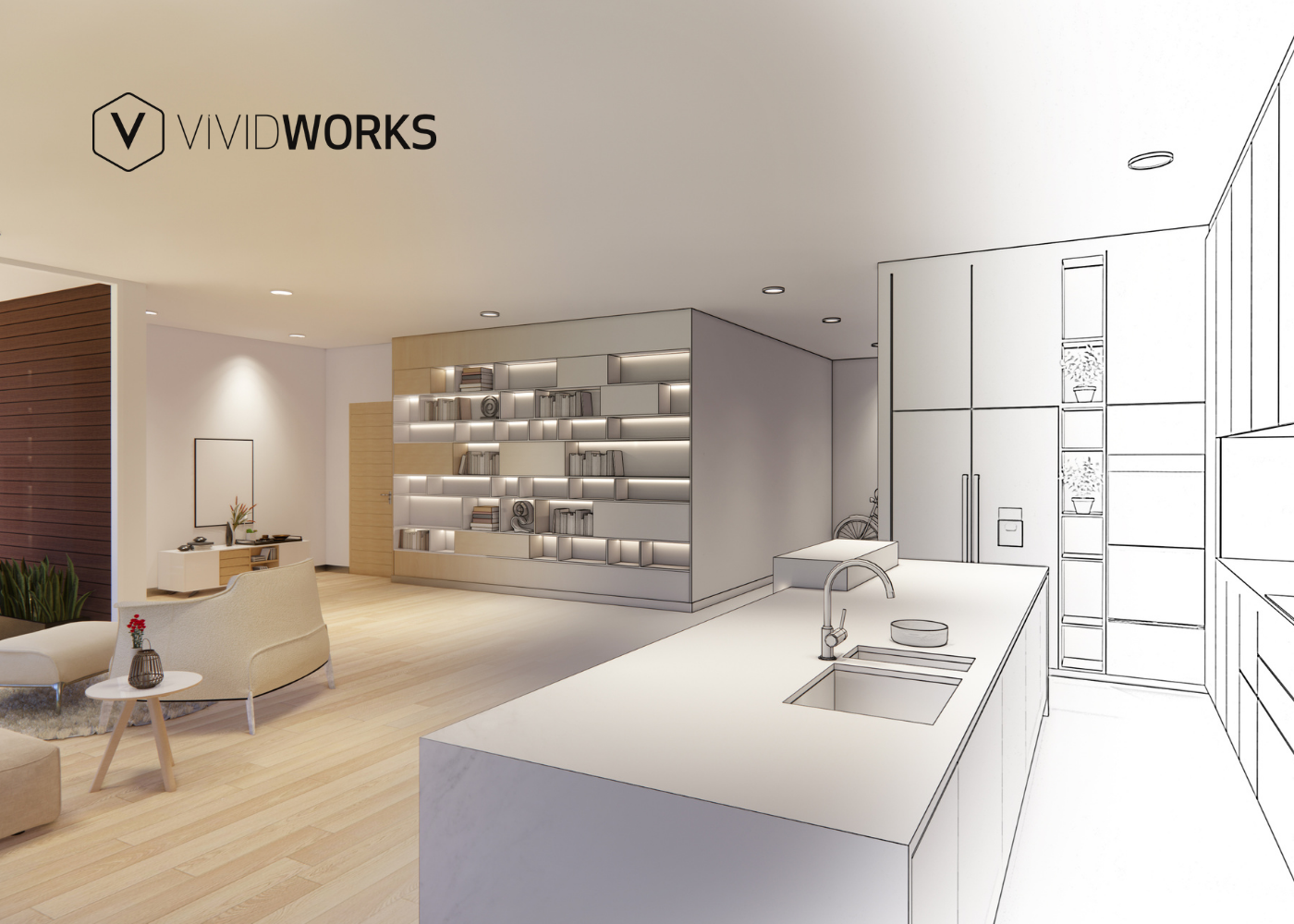A modular fixture is a versatile system built from interchangeable components, allowing for flexible reconfigurations for diverse layouts. Its growth is expected to reach USD 2.5 billion by 2033, becoming a cornerstone of modern retailing. However, selling complex, custom fixtures is not easy. Common challenges that manufacturers suffer from include:
- A Lack of product visuals or impressive experiences;
- Long sales lead time;
- Losing potential customers to agile competitors;
- Quoting errors that lead to dissatisfaction.
The blog today will delve into these hurdles and propose practical strategies. From that, you can direct a proper business plan to optimize your sales results and stay competitive.
Without further ado, let’s discover!
Why Retailers Choose Modular Fixtures?
Modular fixtures have become a top-of-mind choice for many fixture retailers today. Their features align perfectly with the ever-evolving nature of the fixturing market and the growing demand for personalization. Below are the key points that can explain this trend:
- Flexibility and Scalability
First and foremost, modular fixture design is highly evaluated for its inherent flexibility. Modular systems enable swift layout adaptations as stores evolve, allowing retailers to reconfigure current displays for seasonal promotions or refresh their stores’ appearance. They can easily add and remove blocks or modules without the manufacturer’s support.
- Cost-Effectiveness and Space Utilization
Extensive reconfigurability in retail display fixtures allows for adapting existing designs rather than constantly purchasing new fixtures, saving a lot of costs. Additionally, their customizable ability helps maximize floor space, ensuring every space works efficiently.
- Enhanced customer experiences
Shoppers have more chances to access customization options than traditional fixtures. They can adjust the number of modules, dimensions, or colors—all their own. This creates a unique, engaging shopping experience for customers, especially in bespoke industries.
Also, modular fixtures are easy to install, relocate, or dismantle. This saves time for setup and aligns with the target audience, who expect convenience and innovation in reality.
4 Challenges in Selling Complex Modular Fixtures to Retailers
Challenge 1: Lack of Product Visuals
Many retail fixture manufacturers or retail fixture suppliers struggle with visualizing all product options and combinations.. While it is desirable to have a product visualization (2D or 3D) for each design, most salespeople lack the skills or access to the tools required to create them. They often ask the product designers and rely heavily on the designers’ reconfiguration time. As a result, retailers may hesitate to take the following steps, which can lead to lost sales.
Challenge 2: Long Sales Lead Time due to Sales Inefficiencies
Customer demands for a retail fixture can change constantly during the sales process. Each time specifications are altered, the process of creating the design and a new quote must be manually updated. Even back-and-forth communication between sales, design, and manufacturing teams takes time and resources for both manufacturers and retailers. This results in high stress levels for sales teams and excessively long lead times in sales.
Challenge 3: Lose Customers to Competitors
Retailers prefer partners who can offer speed, clarity, and control. That’s also why many leading custom display manufacturers turn to visual configuration software to satisfy this. Therefore, if you cannot ensure instant feedback on design and pricing and provide a visual, engaging purchasing experience, you might risk losing sales to other competitors.
Challenge 4: Prone to quote errors and dissatisfied customers
In today’s fast-moving eCommerce and retailing, relying on outdated modular fixture catalogs and disconnected tools is no longer effective. The lack of real-time updation often causes inaccurate quotes. Consequently, retailers experience unexpected changes or delays due to unavailable parts, leading to a loss of trust and damage to partnerships.
Besides that, manufacturers of retail store fixtures are left dealing with costly operational delays, increased rework, and inefficient resource allocation. These challenges not only reduce productivity but also weaken their competitiveness and hinder business growth.
Strategies and Solutions for Selling Modular Fixtures
Solution 1. Leverage the Role of Product Configurators
One of the most effective solutions is implementing a configurator for display fixtures. Generally, product configurators fall into 2 categories: 2D and 3D. However, with complex, modular designs, 3D configurators have become the go-to choice due to robust features.

3D product configurators provide real–time 3D visualizations and customizations. Users can easily interact with modular fixtures from all angles while modifying key attributes. This immersive experience gives retailers a clearer understanding of the product design. They will have more confidence in their buying decisions, driving a quicker deal closure.
Here are the features that you should look for in your 3D product configuration software:
- Rule-based configuration
This feature ensures that only valid combinations can be created, significantly reducing errors and eliminating the need for manual validation. Manual checks are often a source of mistakes, especially in the design and manufacturing of highly modular products.
- Ready-made logic
Built-in logics are predefined to support complex, highly customizable, and modular products with many interdependencies. This enables seamless handling of intricate configurations without requiring users to create new or custom principles from scratch.
- Augmented Reality (AR)
AR capabilities allow users to project the product design into a real-world environment. This helps retailers visualize how the fixture will look, feel, and fit within their own layout. From that, they can exactly know whether the final designs align with their expectations.
- Seamless integration with your existing system
Integrating your 3D configurator with eCommerce platforms, ERPs, and CRMs creates a unified, automated back-end system for your store. This is especially important when handling high-volume orders because doing everything manually takes time and effort. Of course, you can completely get printing-ready files, BOMs, and assembly instructions.
Mobile responsiveness, 3D room planning, and Virtual Reality (VR) are also powerful enhancements that elevate the customer experience. Depending on the complexity of modular fixtures, manufacturers can consider proper functionalities for your configurator.
Solution 2. Ultilize the CPQ for Sales Efficiency
A Configure, Price, Quote (CPQ) system is widely used in many businesses to streamline their sales performance, and retail display fixture ones are no exception. With complex modular designs, where visuals are especially crucial, Visual CPQ is an ideal alternative.
Visual CPQ allows everyone to configure modular fixtures and see prices and quotes simultaneously. This ensures accurate quotes and eliminates the need for manual steps. And you also don’t need back-and-forth communication, which is often time-consuming.
Grand + Benefits is one of the most successful brands that leverages 3D product configuration and Visual CPQ to improve revenue results when selling modular shelves.
This configurator, empowered by VividWorks, a well-known 3D software provider, enables users to visualize designs in 3D views and get quick quotes. You can customize every detail with pre-built product logic to create your own manufacturable modular shelves. This boosts buyer engagement, reduces technical errors, and shortens the sales cycles.
“Working with VividWorks was a great experience - professional, reliable, and budget-friendly. Their 3D visuals exceeded our expectations and have been a hit with both our team and customers,” says Camilla, Director of Marketing at Grand + Benedicts.
Solution 3. Focus on Engagement and Visual Shopping Experience
According to Forbes, 91% of customers prefer interactive and visual experiences when visiting your websites. That’s why creating a dynamic and immersive journey is the first priority, especially in retail fixture manufacturing, with lots of complex designs displayed.
A system furniture configurator with 3D visualization, AR, or customizable modules is just one typical example of elevating customer engagement via interactive experiences. High-quality product videos, clean navigation, and interactive images are also essential elements. These contribute to high-converting eCommerce stores and drive conversion.
Manufacturers can further enhance engagement by offering personalized consultations through virtual tools or live support. You can guide retailers through their design process, clarify modular fixtures, and increase their confidence in every configuration and choice.
Conclusion: The Importance of Modular Fixtures for Modern Retail
Modular fixtures empower retailers to achieve a high level of flexibility, optimize their resources, and satisfy customers' demand for personalization for improved sales results. To become one of the leading manufacturers in the fixture retailing industry and a big partner of many retailers, you need to embrace more innovations for unique experiences.
3D product configurators, Visual CPQ, AR, or other engagement tools can help you a lot. However, be mindful of proper solutions for the complexity of your modular products and budget; these will position your brand for long-term growth in a competitive market.
Book a demo of VividWorks 3D Configurators and discover how they can transform!
Table of Content
-3.avif)
Streamline your process today!


.png)




